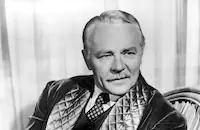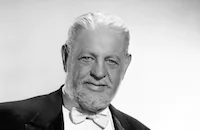The Invisible Woman

Brief Synopsis
Cast & Crew
A. Edward Sutherland
John Barrymore
Virginia Bruce
John Howard
Charles Ruggles
Oscar Homolka
Film Details
Technical Specs

Synopsis
When extravagant playboy Richard Russell exhausts his inheritance, he is forced to discontinue his patronage of eccentric scientist Professor Gibbs. As he is on the verge of perfecting his experiments with invisibility, the professor decides to continue his work and advertises for a subject to test his invention. Answering the call of adventure, model Kitty Carroll consents to become his first subject. The experiment is a success, and the professor rushes to tell Dick that he will be able to recoup his money through sales of the machine. While still invisible, Kitty decides to exact revenge on her abusive boss and disappears. Unable to find the elusive Kitty, Dick decides that the professor has gone mad and retreats to his fishing lodge. Meanwhile, a gang of crooks decides to steal the machine to render their leader, Blackie, invisible so that he can return from his hideout in Mexico. Kitty, her revenge accomplished, returns to the professor, and he drives her to Dick's lodge, where she gets drunk and falls in love with Dick. While Dick is romancing the invisible Kitty, the crooks steal the professor's machine and truck it to Mexico. The next day, a visible Kitty and the professor return to his lab to find the machine missing. In Mexico, the crooks discover that they need the secret formula for the machine to work, and consequently, they return to kidnap Kitty and the professor. Dick, who has fallen in love with Kitty, follows them to Mexico. At Blackie's hideout, Kitty, who has discovered that alcohol will render her invisible, drinks some spirits and captures the entire gang. When Dick arrives, she allows him to rescue her, and all ends happily as they marry and have a semi-invisible baby.

Director
A. Edward Sutherland
Cast

John Barrymore

Virginia Bruce

John Howard

Charles Ruggles

Oscar Homolka

Edward Brophy

Donald Macbride

Margaret Hamilton

Shemp Howard

Anne Nagel
Kathryn Adams

Maria Montez

Charles Lane
Mary Gordon

Thurston Hall
Eddie Conrad
Kay Leslie
Kay Linaker
Sarah Edwards
Kitty O'neil
Harry C. Bradley
Kernan Cripps
Crew
Elwood Bredell
Bernard B. Brown
John Fulton
R. A. Gausman
Frank Gross
Burt Kelly
Joseph Lapis
Robert Lees
Joe May
Joseph Mcdonough
Jack Otterson
Charles Previn
Gertrude Purcell
Richard H. Riedel
Fred Rinaldo
Kurt Siodmak
Vera West

Film Details
Technical Specs

Award Nominations
Best Special Effects
Best Visual Effects
Articles
The Invisible Woman
Based on a story idea by Curt Siodmak, brother of director Robert Siodmak (The Killers, 1946), and Joe May, who, coincidentally, directed The Invisible Man Returns, The Invisible Woman is played for laughs in the comic style of Topper (1937) but on a B-movie budget. The movie serves up two storylines; in the first one, Professor Gibbs (John Barrymore) is trying to perfect his invention for rendering people invisible (don't ask why) even though his patron, millionaire playboy Richard Russell (John Howard), has just gone bankrupt. For his experiment, the scientist solicits through the local newspaper a willing guinea pig - an unemployed fashion model named Kitty (Virginia Bruce) who desperately needs the money. The professor's formula proves to be successful and Kitty slips away undetected to exact mischievous revenge on the fashion store manager who fired her. Meanwhile, the second plot kicks in as a gang of crooks, learning of Professor Gibb's invention, try to steal the machine for their own purposes. Both storylines come together in a climax set in Mexico at the secret hideout of gang leader Blackie (Oskar Homolka) and end on a happy note as Richard and Kitty get married and have a child, who has obviously inherited his mother's invisible abilities according to the final shot.
Directed by A. Edward Sutherland, who got his start working for Mack Sennett in silent comedy shorts and later directed feature films starring Charlie Chaplin (Tillie's Punctured Romance, 1928), W.C. Fields (It's the Old Army Game, 1926) and Laurel and Hardy (The Flying Deuces, 1939), The Invisible Woman is a broad slapstick comedy distinguished by the special effects of John P. Fulton and John D. Hall and a cast of veteran scene stealers including John Barrymore, Charles Ruggles, Margaret Hamilton, Shemp Howard (of The Three Stooges), Charles Lane as the tyrannical store manager and Maria Montez in a bit role.
The Invisible Woman was one of John Barrymore's final films; he would complete two more features before dying in 1942. While no one could make any great claims for his performance here as the whimsical, elderly scientist - he hams it up with gusto and appears to be doing a parody of his own brother, Lionel Barrymore - the actor's presence still lent the movie a certain marquee value at the time. Yet the film is more of a showcase for Virginia Bruce, an attractive and vivacious blonde who rarely broke out of the B-movie rut despite her comedic gifts and musical talent. Bruce is especially appealing here in one of her rare leading roles but ironically, she is invisible, of course, for more than half of her screen time.
While it was never meant to be anything more than a fast-paced, entertaining diversion for undiscriminating moviegoers, The Invisible Woman pleased audiences but critics were harsher in their verdicts. The reviewer for The New York Times wrote, "Perhaps the maddest jape to have arrived hereabouts recently is The Invisible Woman....It is silly, banal and repetitious; it is essentially a two-reel comedy with elephantiasis and full of the trick disappearances and materializations that seemed new when Topper first came out. The script is as creaky as a two-wheeled cart and were it not for the fact that John Barrymore is taking a ride in it we hate to think what The Invisible Woman might have turned out to be. But Mr. Barrymore takes to this trash as if he were to the manner born."
If anything, The Invisible Woman is the sort of film that could benefit from a remake, one that could capitalize and improve on some of its best sequences. Most of these involve Ms. Bruce taking revenge on her former boss and finding liberation and empowerment in her invisible state; its possibilities as a feminist comedy set in a working class milieu are more than promising.
Released in December of 1940, The Invisible Woman actually managed to snag an Academy Award nomination for Best Special Effects in the 1941 Oscar® race but it lost to I Wanted Wings (1941).
Director: A. Edward Sutherland
Screenplay: Curt Siodmak, Joe May (story); Robert Lees, Fred Rinaldo, Gertrude Purcell
Cinematography: Elwood Bredell
Art Direction: Jack Otterson
Music: Frank Skinner (uncredited)
Film Editing: Frank Gross
Cast: Virginia Bruce (Kitty Carroll), John Barrymore (Professor Gibbs), John Howard (Richard Russell), Charlie Ruggles (George), Oskar Homolka (Blackie), Edward Brophy (Bill), Donald MacBride (Foghorn), Margaret Hamilton (Mrs. Jackson), Shemp Howard (Frankie), Anne Nagel (Jean).
BW-72m.
by Jeff Stafford
SOURCES:
Damned in Paradise: The Life of John Barrymore by John Kobler (Atheneum) The Barrymores by Hollis Alpert (The Dial Press) The Universal Story by Clive Hirschhorn (Crown Publishers)

The Invisible Woman
Quotes
Trivia
Notes
According to a news item in Hollywood Reporter, Margaret Sullavan was to have played the lead in this picture, but refused the role. In the film, the character name "Grawley" is spelled two different ways. In the opening credits it is spelled "Grawley," while on his office door it is printed as "Growley." For other Universal films about invisibility, see entry above for The Invisible Man.















